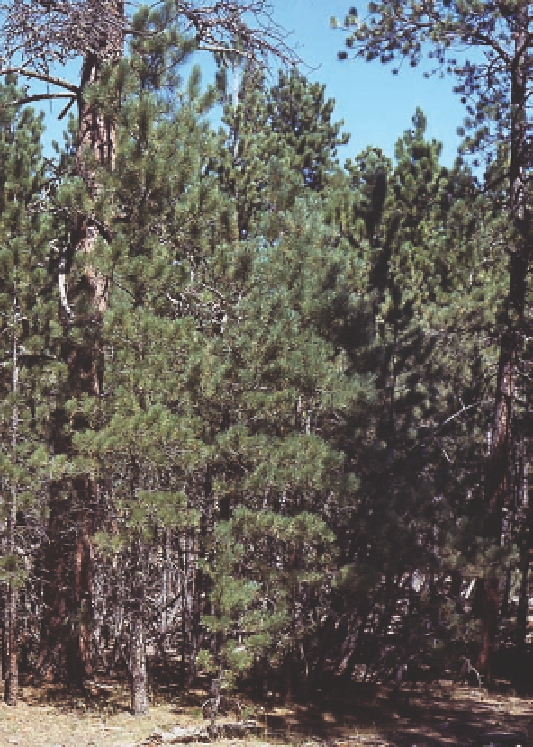Geoscience Reference
In-Depth Information
Fig. 11.8. on the left is an open ponderosa pine forest on
a moderately moist site in the Laramie Mountains south of
Douglas. the thick bark of mature ponderosa pine protects
many trees from easily controlled surface fires that kill
smaller trees, although some are scarred (see fig. 11.9). in the
same area, ponderosa pine forests develop extremely high tree
densities after long periods without fire or other disturbances
that coincide with climatic conditions favorable for seedling
establishment, as illustrated on the right. Such dense forests
are highly susceptible to severe wildfires. elevation 6,700 feet.
summer precipitation is higher and the growing season
is warmer and longer (see figs. 1.5 and 3.4), especially
in the Black Hills and on the east slopes of the Bighorn
and Laramie mountains. the importance of summer
precipitation is illustrated by the absence of ponderosa
pine on the southern end of the Bighorn canyon, in the
desert-like Bighorn Basin, and its presence at the same
elevation on the northern end of the canyon, where
summer rainfall is much higher (19 inches compared
to 7 inches). Ponderosa pine is also abundant in por-
tions of the Uinta Mountains in Utah, the east slopes of
the colorado Front Range, and throughout the moun-
tains of southern colorado, new Mexico, and Arizona.
in all these areas, as on the Great Plains, a large por-
tion of the annual precipitation occurs in the summer.
the importance of warmer temperatures was suggested
by a laboratory study that found that ponderosa pine
seedlings are more sensitive to cold temperatures than
were those of lodgepole pine, which is found at higher
pine is generally absent from the
frost pockets
in depres-
sions, where cold air accumulates. Ponderosa pine is
a relative newcomer near the northeastern limit of its
distribution, such as in Wyoming, and probably is still
moving northward from Pleistocene refugia far to the
south (see chapter 2). climate warming may accelerate
tree density in ponderosa pine forests is a function
of local growing conditions and disturbance frequency
and severity (fig. 11.8). on relatively wet sites, ponder-


Search WWH ::

Custom Search